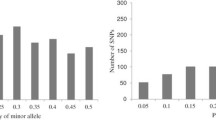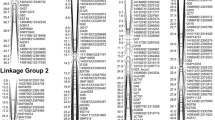Abstract
Restriction fragment length polymorphism (RFLP) analysis was used to characterize variability in the Illinois Long-Term Selection Experiment oil strains. Considerable polymorphism was detected within each oil strain and among oil strains. Fifty-two individual plants from each of the Illinois High Oil (IHO), Illinois Low Oil (ILO), Reverse High Oil (RHO) and Reverse Low Oil (RLO) strains were sampled to determine RFLP allele/variant frequencies. Generation 90 was sampled for IHO, RHO, and RLO whereas generation 87 was sampled for ILO. Forty-nine RFLP probes distributed throughout the maize genome were used. Chi-square analysis was performed to determine if RFLP genotypes at each of the 49 RFLP loci were significantly different among strains. Oil strains that have been separated for 90 generations showed high levels of significantly-different RFLP genotypic frequencies. The comparison of ILO vs RHO gave only significant chi-square values while the comparisons of IHO vs RLO and RHO vs RLO had 11∶1 ratios of significant to non-significant chi-square values. Strains that have been separated for only 42 generations showed a lower level of significantly-different RFLP genotypic frequencies. The comparisons of IHO vs RHO and ILO vs RLO both had only a 3∶2 ratio of significant to non-significant chi-squares values. Detection of multiple RFLP alleles/variants among the oil strains was common with 59% of the RFLP loci examined exhibiting multiple variants. A number of RFLP loci in RHO (3) and RLO (11) were associated with a trend in RFLP allele/variant frequencies consistent with a response to reverse selection for oil concentration.
Similar content being viewed by others
References
Adams KL, Jensen AH (1988) High-fat maize in diets for pigs and sows. Anim Feed Sci Technol 17:201–212
Alexander DE (1988) Breeding special nutritional and industrial types. In: Sprague GF Dudley JW (eds) Corn and corn improvement 3rd edn. Agron Monogr 18. ASA, Madison, Wisconsin, pp 869–880
Atwell DG, Jaster EH, Morre KL, Fernando RL (1988) Evaluation of high oil corn and corn silage for lactating cows. J Dairy Sci 71:2689–2698
Brown AHD (1971) Isozyme variation under seletion in Zea mays. Nature 232:570–571
Brown AHD, Allard RW (1971) Effect of reciprocal recurrent selection for yield on isozyme polymorphism in maize (Zea mays L.) Crop Sci 11:888–893
Cochran WG (1954) Some methods for strengthening the common x2 tests. Biometrics 10:417–451
Dudley JW, Lambert RJ (1992) Ninety generations of selection for oil and protien in maize. Maydica 37:1–7
Dudley JW, Lambert RJ, Alexander DE (1974) Seventy generations of selection for oil and protein concentration in the maize kernel. In: Dudley JW (ed) Seventy generations of selection for oil and protein in maize. ASA, CSSA, and SSSA, Madison, Wisconsin, pp 181–211
Dudley JW (1977) Seventy-six generations of selection for oil and protein percentage in maize. In: Pollak E, Kempthorne O, Bailey TB Jr (eds) Proc. of the Int Conf Quant Genet Aug 16–21, 1976. Iowa State Univ. Press, Ames Iowa, pp 459–474
Dudley JW, Lambert RJ, de la Roche I (1977) Genetic analysis of crosses among corn strains divergently selected for percent oil and protein. Crop Sci 17:11–117
Goldman I, Rocheford T, Dudley J, Tadmor Y, Juvik J, Marcotte B (1992) Molecular marker mapping for chromosomal regions influencing maize kernel composition traits. Plant Genome I Abstr: p 45
Goss J, Kerr PS (1992) Challenges and opportunities for identity preserved varieties. In: Proc 47th Annu Corn and Sorghum Res Conf. American Seed Trade Association, Washington, D.C., pp 82–92
Han Y, Parsons CM, Alexander DE (1987) The nutritive value of high-oil corn kernel for poultry. J Poult Sci 66:103–111
Hopkins CG (1899) Improvement in the chemical composition of the corn kernel. In: Dudley JW (ed) Seventy generations of selection for oil and protein in maize. ASA, CSSA, and SSSA, Madison, Wisconsin, pp 1–31
Hoisington D (1989) University of Missouri RFLP Manual
Kahler AL (1985) Association between enzyme marker loci and agronomic traits in maize. In: Proc 40th Annu Corn and Sorghum Res Conf. American Seed Trade Association, Washington, D.C., pp 66–89
Lee M (1991) Iowa State University: laboratory protocol for RFLP analyses
Leng ER (1962) Results of long-term selection for chemical composition in maize and their significance in evaluating breeding systems. In: Dudley JW (ed) Seventy generations of selection for oil and protein in maize. ASA, CSSA, and SSSA, Madison, Wisconsin, pp 149–173
Maize Working Map (1992) Maize Genet Newslett. 66:150–159
Miller RI, Dudley JW, Alexander DE (1981) High-intensity selection for percent oil in corn. Crop Sci 21:433–437
Misevic D, Alexander DE, Dumanovic J, Ratkovic S (1985) Recurrent selection for percent oil in corn. Genetika (Yugoslavia) 17:97–106
SAS (1988) STAT user's guide, release 6.03 edition SAS Institute Inc., Cary North Carolina, USA
Saghai-Maroof MA, Soliman KM, Jorgensen RA, Allard RW (1984) Ribosomal DNA spacer-length polymorphisms in barley: Mendelian inheritance, chromosomal location, and population dynamics. Proc Natl Acad Sci USA 81:8014–8018
Sambrook J, Fritsch EF, Maniatis T (1989) Molecular cloning: a laboratory manual. Cold Spring Harbor Laboratory, Cold Spring Harbor, New York
Steel RGD, Torrie JH (1980) Principles and procedures of statistics. McGraw-Hill Book Co., New York
Stuber CW, Moll RH (1972) Frequency changes in isozyme alleles in a selection experiment for grain yield in maize (Zea mays L.). Corp Sci 12:337–340
Stuber CW, Moll RH, Goodman MM, Schaffer HE, Weir BS (1980) Allozyme frequency changes associated with selection for increased grain yield in maize (Zen mays L.). Genetics 95:255–236
Sughroue JR, Tadmor Y, Berke T, Mikkilineni V, Goldman I, Rocheford T (1992) Evaluation of changes in molecular marker frequency in maize long-term selection experiments. Plant Genome I Abstr: p 49
Tsumura Y, Motoike H, Ohba K (1992) Allozyme variation of old Ginko biloba memorial trees in western Japan. Can J For Res 22:939–944
Wilson CM (1992) Zein diversity in Reid, Lancaster, and Illinois Chemical corn strains revealed by isoelectric focusing. Crop Sci 32:869–873
Author information
Authors and Affiliations
Additional information
Communicated by A. R. Hallauer
Rights and permissions
About this article
Cite this article
Sughroue, J.R., Rocheford, T.R. Restriction fragment length polymorphism differences among Illinois long-term selection oil strains. Theoret. Appl. Genetics 87, 916–924 (1994). https://doi.org/10.1007/BF00225785
Accepted:
Issue Date:
DOI: https://doi.org/10.1007/BF00225785




